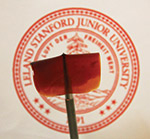
A new, extremely stretchable polymer film created by Stanford researchers can repair itself when punctured, a feature that is important in a material that has potential applications in artificial muscle. Photograph courtesy of the Bao Research Group.
Researchers with the Bao Research Group at Stanford University have developed a new polymer that is highly stretchable, can self-repair itself if punctured, and twitches or pulses in a muscle-like fashion when jolted with an electrical field. Not only does the substance have long-term potential for use as artificial muscle, the research dovetails efforts by Stanford chemical engineering Professor Zhenan Bao, PhD, to create artificial skin that might be used to restore sensory capabilities to people with prosthetic limbs. The new, durable polymer could form part of the physical structure of a fully developed artificial skin. The study, “A Highly Stretchable Autonomous Self-healing Elastomer,” was published online April 18 in the journal Nature Chemistry.
Bao’s team member, Cheng-Hui Li, PhD, a visiting scholar from China, synthesized the new elastomer. The team attributes the extreme stretching and self-healing ability of the new material to some critical improvements to a type of chemical bonding process known as crosslinking. This process, which involves connecting linear chains of linked molecules in a sort of fishnet pattern, has previously yielded a tenfold stretch in polymers.
First, Li and his colleagues designed special organic molecules to attach to the short polymer strands in their crosslink to create a series of structure called ligands. These ligands joined to form longer polymer chains-spring-like coils with inherent stretchiness. Then they added metal ions. When this combined material is strained, the knots loosen and allow the ligands to separate. When relaxed, the affinity between the metal ions and the ligands pulls the material taut. The team also found that they could tune the polymer to increase its stretchiness or heal faster by varying the amount or type of metal ion included. They have to do more work to increase the degree to which the material expands and contracts and control it more precisely. But this observation opens the door to promising applications, they said.
To find the breaking point of their one inch sample, Li and another lab member held opposing ends in their hands, moving further and further apart, eventually stretching a one inch polymer film to more than 100 inches. Such materials can normally be stretched only two or three times their original length. The researchers also showed that they could make this new elastomer twitch by exposing it to an electric field, causing it to expand and contract, making it potentially useful as artificial muscle. Additionally, while damaged polymers typically require a solvent or heat treatment to restore their properties, the new material showed an ability to heal itself at room temperature, even if the damaged pieces were aged for days.
Even before artificial muscle and artificial skin become practical, this work could spawn a new generation of wearable electronics or medical implants that would last a long time without being repaired or replaced.
Editor’s note: This story was adapted from materials provided by Stanford University.




